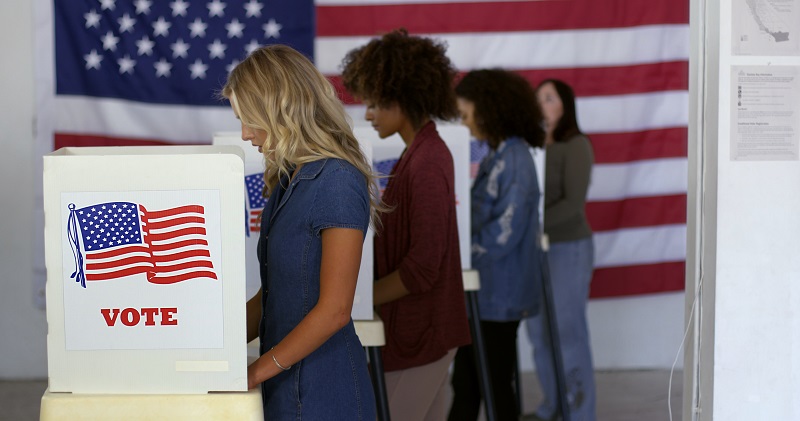Proposition 50 good for Democrats
By David Lightman
The Sacramento Bee
(The Sacramento Bee) — The triumph of California’s Proposition 50 Tuesday doesn’t suddenly mean Democrats get a big boost in their effort to control the House of Representatives next year. But it sure helps.
If the final numbers show more than 60% approval, that’s not only a “huge win” for the party, “this could motivate Democrats in other states to engage in similar and surprising actions,” said Christian Grose, academic director of the University of Southern California Schwarzenegger Institute.
Democrats already have one advantage: Historically, the party out of power at the White House dominates midterm elections. There are variables, though: The state of the economy has a big influence on voter sentiment, and partisanship has become far more important than in the past.
Gov. Gavin Newsom’s Prop. 50 plan involves redistricting the state’s House seats to make it easier for Democrats to win five seats now held by Republicans – a response to Texas’ decision this summer to redraw lines to make it easier for five of that state’s GOP candidates to win Democrat-held seats.
The plan’s win “would functionally negate the gains Republicans made in their redraw of Texas,” said Matthew Klein, U.S. House and governor analyst for the nonpartisan Cook Political Report.
Proposition 50 good for Democrats
Democrats need a net gain of three seats next year to win control of the House for the first time in four years. President Donald Trump this year urged Republican-led states to redraw lines to make it easier for Republicans to hold off Democrats.
Texas went first. Other Republican states, where it’s easier to redistrict, quickly followed. Newsom fought back. So has Virginia. Maryland is inching that way.
Here’s why the 2026 trends are difficult to predict:
Is a Democratic wave starting?
Through most of modern history, the party that controls the White House gets clobbered two years after taking office. Trump’s party lost a net 40 seats in 2018. President Barack Obama’s Democratic Party lost 63 in 2010. On average the party out of power wins 29 seats.
“Midterm elections are often wave elections. This one, at least on paper, seems to have a lot of the ingredients for that,” said Kyle Kondik, managing editor of Sabato’s Crystal Ball, an independent analysis firm.
“Could the usual midterm factors (such as) lower turnout, disillusionment with the incumbent, etc., be an even bigger factor in the midterms than redistricting?” he asked.
The president’s Gallup Poll approval rating, usually a barometer for measuring congressional election prospects, is unusually low.
“Trump’s third-quarter average approval is well below the historical norm for first-term elected presidents and most, but not all, second-term presidents at a similar stage in their presidencies,” said Megan Brenan in her analysis for the Gallup Poll.
Trump is averaging 40.3% this quarter. Only President Richard Nixon, at 31.8%, was lower at this point in his second term. He was dogged by the Watergate scandal at the time.
The Trump numbers suggest, “If this looks like a typical midterm … Democrats will still take back the majority,” said Jacob Rubashkin, deputy editor for Inside Elections.
Even if Republicans gain the maximum number they can get from redistricting, as many as 16 or 17 seats, that may not be enough, he said. One sign of trouble for the GOP: After the Proposition 50 results started coming in, the Cook Report said 10 California House seats now trended more towards Democrats.
Will the economy sink or boom?
Elections historically turn on how people feel about the economy.
When Obama’s party lost big in 2010, the country was emerging from the Great Recession. Unemployment remained close to 10% and Republicans were angry that Obamacare was mandating health care coverage for most people.
The UCLA Anderson Forecast last month predicted slow but steady growth next year, a finding echoed by most economists, with the rate of inflation somewhat less than it is now. But consumers are worried.
Last month, “consumers were a bit more pessimistic about future job availability and future business conditions while optimism about future income retreated slightly,” said Stephanie Guichard, senior economist, Global Indicators at The Conference Board, an independent group that conducts consumer sentiment surveys.
An NBC News poll taken last week found that by a 2-to-1 margin, voters are dissatisfied with how the Trump administration has handled the economy.
How polarized is the electorate?
Voting trends could put the brakes on a partisan wave. “Voting patterns are more ingrained than they were 10 years ago,” said Christopher Cooper, professor of political science at Western Carolina University.
North Carolina is redrawing its map in an effort to topple Rep. Don Davis, D-N.C.
Thanks to technology’s ability to make it easier to draw highly partisan congressional districts, and the growing polarization among voters, he saw fewer swing districts.
In California, two of the 52 House districts are viewed by Inside Elections and other analysts as true toss-ups, seats now held by Reps. Adam Gray, D-Merced, and Derek Tran, D-Garden Grove.
Under the new map, the seats held by Rep. David Valadao, R-Hanford, and possibly Kevin Kiley, R-Rosedale, may now be in that category.
Klein, of the Cook Report, said that the Republican redistricting effort “nets a few seats in the end.”
“That could help them if Democrats have an unusually weak midterm cycle,” he said, “but the redraws alone probably won’t be enough to overcome the typical headwinds faced by the party in power.”
©2025 The Sacramento Bee. Visit sacbee.com. Distributed by Tribune Content Agency, LLC.


